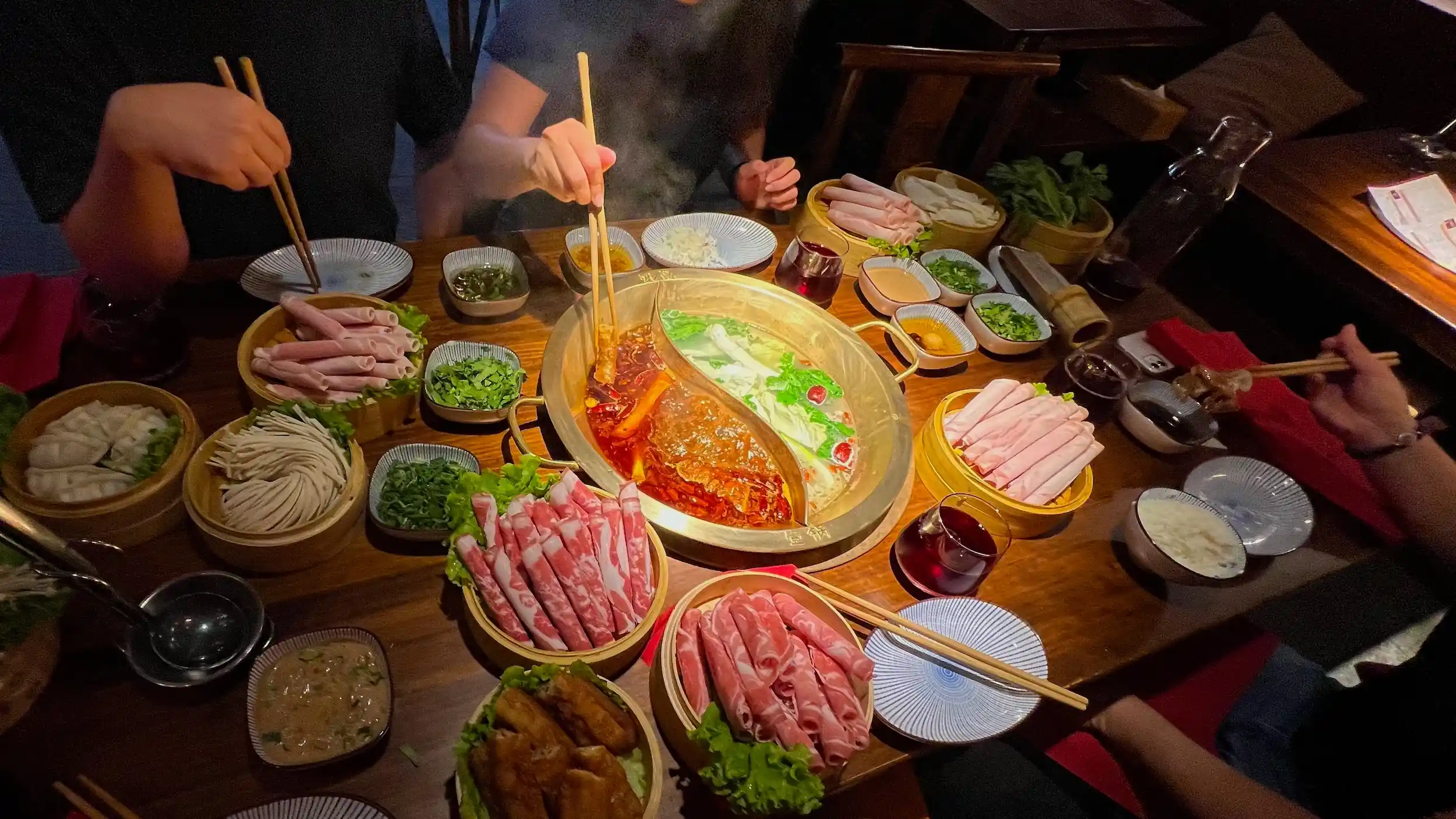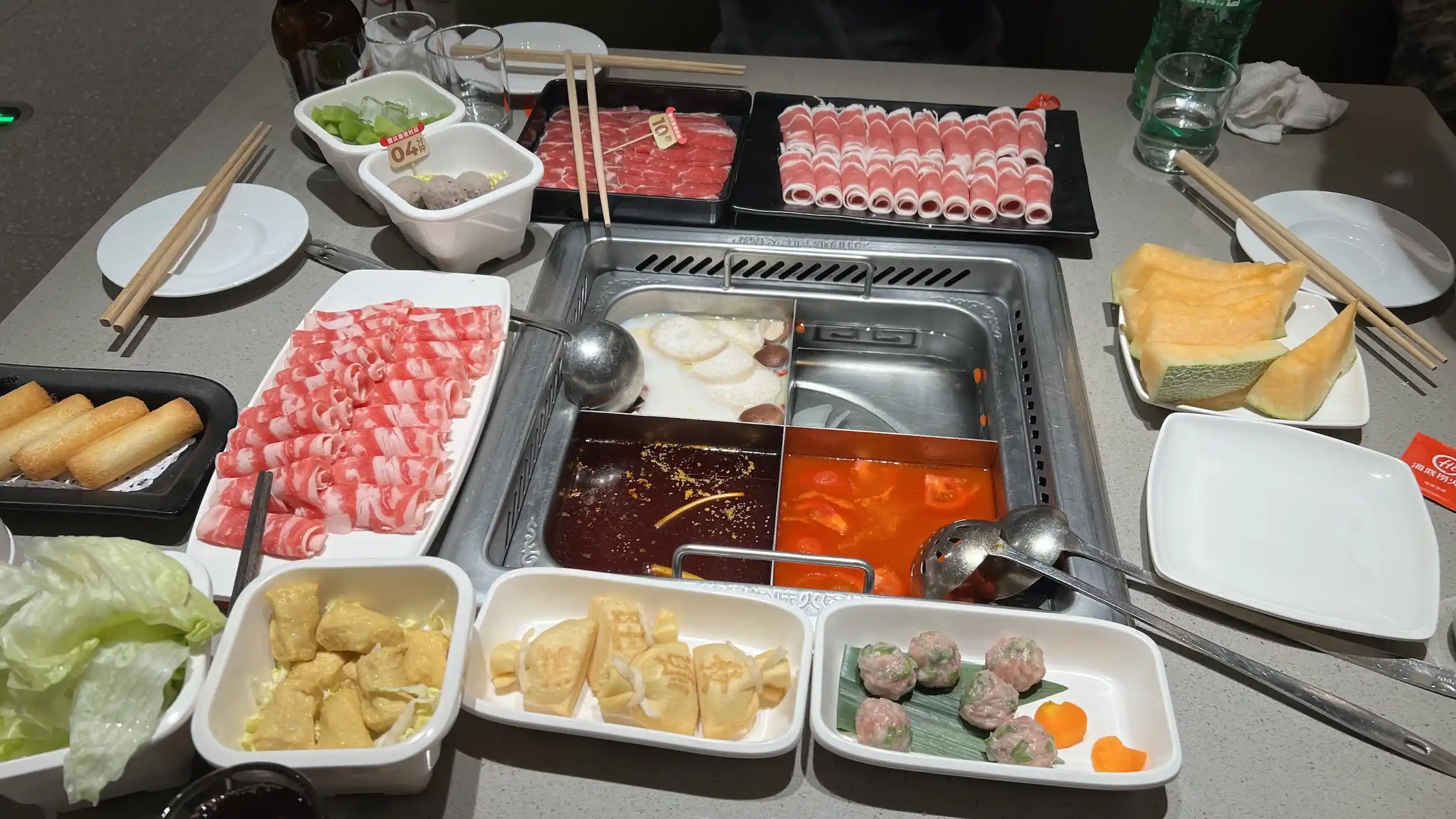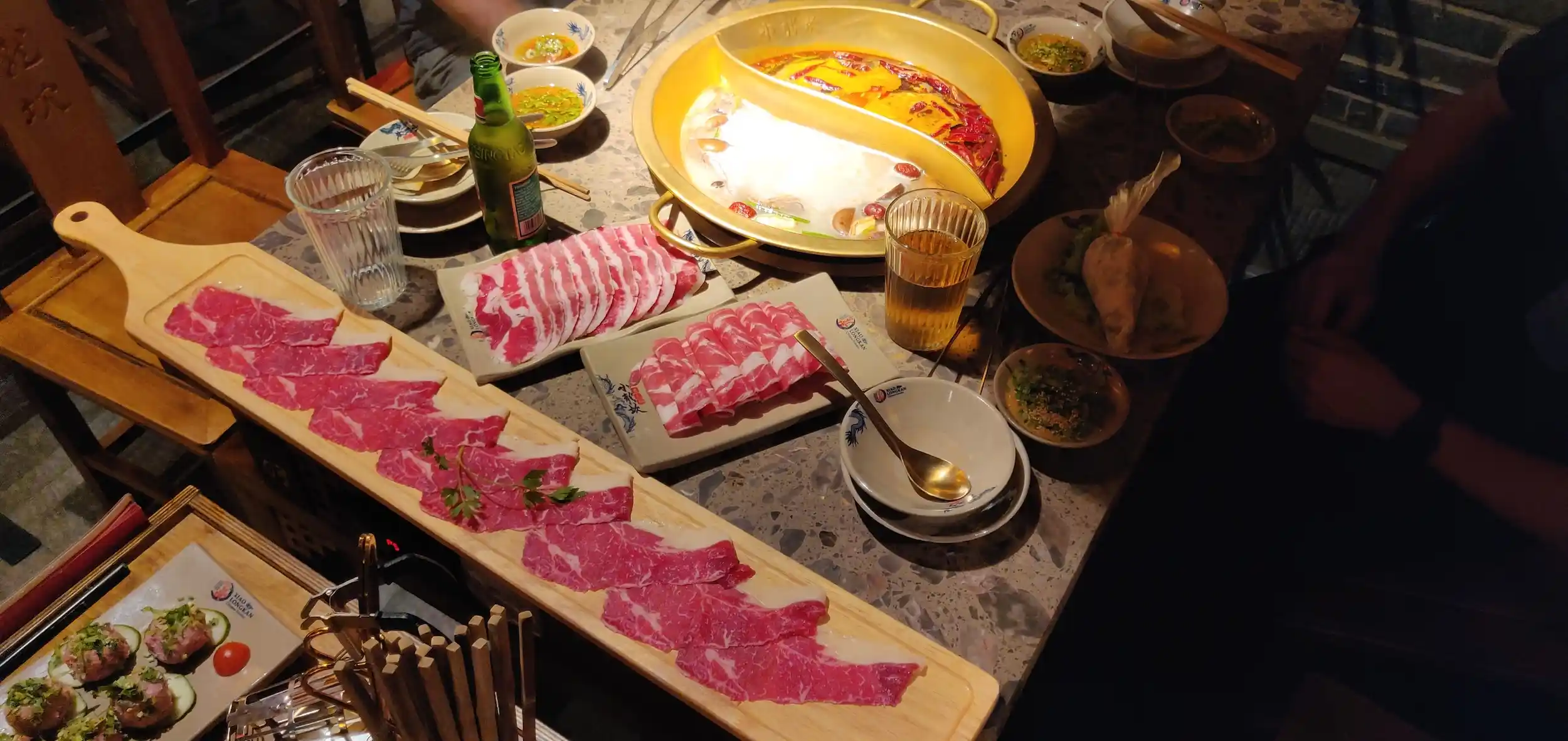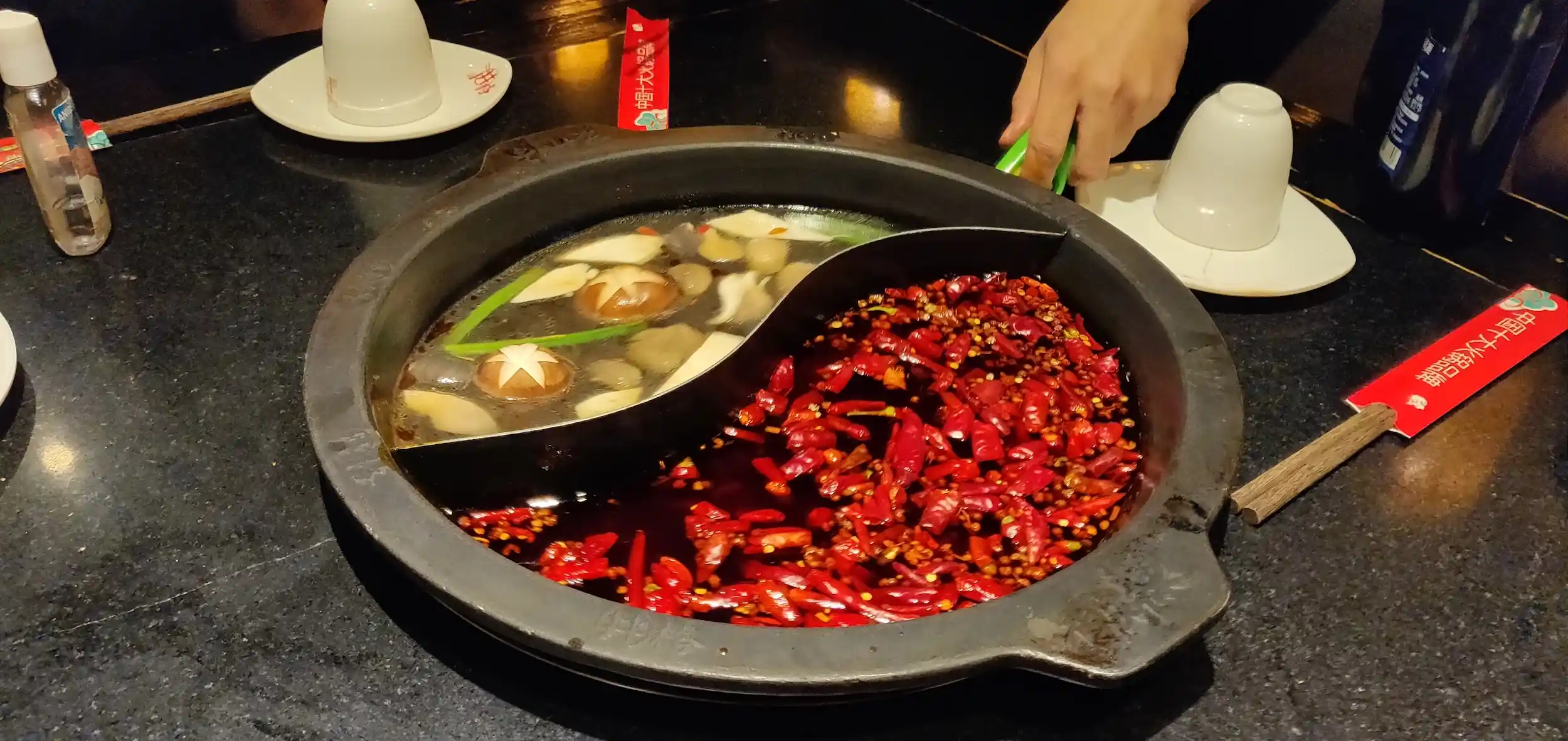
Hotpot (火锅, huǒguō) is much more than a simple dish in Chinese cuisine; it represents a complete social experience where the act of eating becomes a celebration shared with friends and family.
This cooking method, which consists of a boiling pot in the center of the table where diners submerge and cook various ingredients, has conquered palates throughout China and is now spreading worldwide.
In each region of China, hotpot is prepared differently. Its sauces, ingredients, and broth base vary according to geography and the diners’ preferences.
The base broth can be as simple as a few boiled aromatic ingredients or a thick broth based on tomato, fish, or lamb. There is a hotpot for every palate. While it is known worldwide as a spicy dish, it doesn’t have to be. There are numerous non-spicy variations.
Origin of hotpot
Hotpot has its roots in ancient China, dating back more than 1,000 years. Historical records indicate that its origin may date back to the Tang Dynasty (618-907 AD), although it gained greatest popularity during the Ming Dynasty (1368-1644).
Although there is no single place of origin, Chongqing (formerly part of the now independent Sichuan province) is considered the birthplace of modern spicy hotpot (麻辣火锅, málà huǒguō). From there, it spread to the rest of China, becoming one of the most popular and recognizable dishes in Chinese cuisine.

This version of hotpot is characterized by its intense spicy flavors.
Over the centuries, each region of China has developed its own variation, adapting the dish to local ingredients and culinary preferences.
The hotpot ritual
Eating hotpot is as much a social event as it is a gastronomic one. A divided cauldron (usually in two sections for different broths) is placed in the center of the table over a burner or electric stove.
Diners select raw ingredients from shared dishes and cook them in the simmering broth slowly throughout the meal.
To enjoy hotpot properly, follow these steps:
- Once the broth boils, begin dipping in flavorful ingredients such as meat, mushrooms, or tofu.
- The meat, sliced thinly, is cooked quickly (10-30 seconds depending on the type).
- Vegetables require varying times depending on their toughness; allow them to cook long enough.
- Each bite is optionally dipped in a personal sauce that each diner prepares according to their preferences and keeps in their small individual bowl.
Hotpot meals often last for hours, combining eating and socializing in a relaxed atmosphere. They are often accompanied by freshly cut fruit such as watermelon and plenty of drinks to combat the heat from the boiling cauldron.
Broth varieties

The basis of hotpot is the broth, which defines the character of the dish. Here are some of the most popular:
- Sichuan broth (麻辣火锅, málà huǒguō): Intensely spicy and aromatic, made with Sichuan peppercorns, chilies, and spiced oils that produce a characteristic numbness in the mouth.
- Clear broth (清汤火锅, qīngtāng huǒguō): A smooth base prepared with chicken or pork bones, ideal for appreciating the natural flavor of the ingredients.
- Tomato broth (番茄火锅, fānqié huǒguō): Refreshing and slightly acidic, popular in northern China.
- Mushroom broth (菌菇火锅, jùngū huǒguō): Rich in umami, made with various varieties of mushrooms.
- Lamb broth (羊肉火锅, yángròu huǒguō): Traditional to Inner Mongolia and northern regions, spiced with cumin and herbs.
Essential ingredients

The magic of hotpot lies in the diversity of ingredients that can be cooked in it:
- Meats: Mainly thin slices of beef and lamb. Marbled beef (肥牛, féiniú) is especially popular. Pork or chicken can also be added, but this is less common.
- Seafood: Shrimp, scallops, squid, and various types of fish.
- Vegetables: Chinese cabbage (baicài), spinach, bamboo shoots, potatoes, and various types of mushrooms such as shiitake (xiānggū) and enoki (jinzhēngū).
- Tofu: In many varieties, including fresh tofu, fried tofu (yóudòufu), and frozen tofu (dòngdòufu).
- Noodles: Rice noodles, potato noodles, or transparent noodles (fěnsī).
- Frozen dumplings: Made with fish, shrimp, or meat, very popular for their texture.
- Viscera: Tripe, stomach, and other organs, for the more adventurous.
China’s passion for hotpot
Hotpot has achieved an almost mythical status in Chinese food culture for several reasons.
The concept of sharing food reflects traditional Chinese values such as family and community. Eating from the same pot symbolizes unity and harmony. Furthermore, the interactive nature of hotpot makes it a natural center for socializing.
Its versatility allows it to be adapted to all tastes and dietary preferences. Each person can choose which ingredients to cook and for how long, completely personalizing their experience.
In winter, the heat of the pot provides physical and emotional comfort, while in summer, especially the spicy versions, they cause sweating, which according to traditional Chinese medicine helps eliminate toxins.
Where to eat hotpot during your China trip
These are some of the most renowned chains where you can enjoy an authentic hotpot experience during your trip to China:
- Haidilao (海底捞, Hǎidǐlāo): The most famous chain, known for its exceptional customer service. They offer free manicures, babysitting, and even “dancing noodle” shows while you wait for a table.
- Xiabu Xiabu (呷哺呷哺, Xiābǔ Xiābǔ): Popular for quick, individual hotpot meals, ideal for solo travelers.
- Little Sheep (小肥羊, Xiǎo Féiyáng): Specializing in Mongolian hotpot with delicious lamb broth.
- Chongqing Liuyishou (刘一手, Liú Yìshǒu): Famous for its authentic, extremely spicy Chongqing hotpot.
- Shudaxia (蜀大侠, Shǔ Dàxiá): Known for its Sichuan-style hotpot with excellent sauces.

Hotpot is not just a meal; it’s a cultural experience that reflects the Chinese culinary philosophy of balance, community, and adaptability. It perfectly embodies how Chinese cuisine elevates the act of eating into an artistic expression of social and cultural values.
Contact us if you’re planning a trip to China and want to experience authentic hotpot and other local culinary delights.
Asiahop will design a tailor-made private itinerary combining the best places to taste this delicacy with the country’s top attractions.
Are you interested in the Chinese gastronomy? Read more about Chinese food from Asiahop